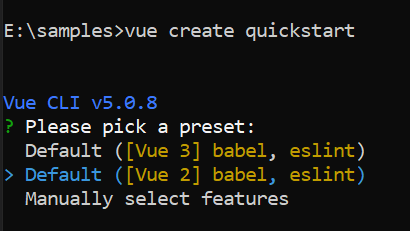Getting Started with the Vue Color picker Component in Vue 2
25 Apr 20257 minutes to read
This article provides a step-by-step guide for setting up a Vue 2 project using Vue-CLI and integrating the Syncfusion® Vue Color picker component using the Composition API / Options API.
Prerequisites
System requirements for Syncfusion® Vue UI components
Dependencies
The list of dependencies required to use the ColorPicker component in your application is given below:
|-- @syncfusion/ej2-vue-inputs
|-- @syncfusion/ej2-vue-base
|-- @syncfusion/ej2-base
|-- @syncfusion/ej2-inputs
|-- @syncfusion/ej2-buttons
|-- @syncfusion/ej2-popups
|-- @syncfusion/ej2-splitbuttonsSetting up the Vue 2 project
To generate a Vue 2 project using Vue-CLI, use the vue create command. Follow these steps to install Vue CLI and create a new project:
npm install -g @vue/cli
vue create quickstart
cd quickstart
npm run serveor
yarn global add @vue/cli
vue create quickstart
cd quickstart
yarn run serveWhen creating a new project, choose the option Default ([Vue 2] babel, eslint) from the menu.

Once the quickstart project is set up with default settings, proceed to add Syncfusion® components to the project.
Add Syncfusion® Vue packages
Syncfusion® packages are available at npmjs.com. To use Vue components, install the required npm package.
This article uses the Vue Color picker component as an example. Install the @syncfusion/ej2-vue-inputs package by running the following command:
npm install @syncfusion/ej2-vue-inputs --saveor
yarn add @syncfusion/ej2-vue-inputsImport Syncfusion® CSS styles
You can import themes for the Syncfusion® Vue component in various ways, such as using CSS or SASS styles from npm packages, CDN, CRG and Theme Studio. Refer to themes topic to know more about built-in themes and different ways to refer to themes in a Vue project.
In this article, the Material theme is applied using CSS styles, which are available in installed packages. The necessary Material CSS styles for the Color picker component and its dependents were imported into the <style> section of src/App.vue file.
<style>
@import '../node_modules/@syncfusion/ej2-base/styles/material.css';
@import '../node_modules/@syncfusion/ej2-buttons/styles/material.css';
@import '../node_modules/@syncfusion/ej2-popups/styles/material.css';
@import '../node_modules/@syncfusion/ej2-splitbuttons/styles/material.css';
@import '../node_modules/@syncfusion/ej2-inputs/styles/material.css';
</style>Add Syncfusion® Vue component
Follow the below steps to add the Vue Color picker component using Composition API or Options API:
1. First, import and register the Color picker component in the script section of the src/App.vue file. If you are using the Composition API, you should add the setup attribute to the script tag to indicate that Vue will be using the Composition API.
<script setup>
import { ColorPickerComponent as EjsColorpicker } from '@syncfusion/ej2-vue-inputs';
</script><script>
import { ColorPickerComponent } from '@syncfusion/ej2-vue-inputs';
export default {
name: "App",
components: {
"ejs-colorpicker':":ColorPickerComponent
}
}
</script>2. In the template section, define the Color picker component.
<template>
<div class='wrap'>
<h4>Choose Color</h4>
<ejs-colorpicker></ejs-colorpicker>
</div>
</template>Here is the summarized code for the above steps in the src/App.vue file:
<template>
<div class='wrap'>
<h4>Choose Color</h4>
<ejs-colorpicker></ejs-colorpicker>
</div>
</template>
<script setup>
import { ColorPickerComponent as EjsColorpicker } from '@syncfusion/ej2-vue-inputs';
import { enableRipple } from '@syncfusion/ej2-base';
enableRipple(true);
</script>
<style>
@import '../node_modules/@syncfusion/ej2-base/styles/material.css';
@import '../node_modules/@syncfusion/ej2-buttons/styles/material.css';
@import '../node_modules/@syncfusion/ej2-popups/styles/material.css';
@import '../node_modules/@syncfusion/ej2-splitbuttons/styles/material.css';
@import '../node_modules/@syncfusion/ej2-inputs/styles/material.css';
.wrap {
margin: 0 auto;
width: 300px;
text-align: center;
}
</style><template>
<div class='wrap'>
<h4>Choose Color</h4>
<ejs-colorpicker></ejs-colorpicker>
</div>
</template>
<script>
import { ColorPickerComponent } from '@syncfusion/ej2-vue-inputs';
import { enableRipple } from '@syncfusion/ej2-base';
enableRipple(true);
export default {
name: "App",
components: {
"ejs-colorpicker": ColorPickerComponent
}
}
</script>
<style>
@import '../node_modules/@syncfusion/ej2-base/styles/material.css';
@import '../node_modules/@syncfusion/ej2-buttons/styles/material.css';
@import '../node_modules/@syncfusion/ej2-popups/styles/material.css';
@import '../node_modules/@syncfusion/ej2-splitbuttons/styles/material.css';
@import '../node_modules/@syncfusion/ej2-inputs/styles/material.css';
.wrap {
margin: 0 auto;
width: 300px;
text-align: center;
}
</style>Run the project
To run the project, use the following command:
npm run serveor
yarn run serveInline type
By default, the ColorPicker will be rendered using SplitButton and open the pop-up to access the ColorPicker. To render the ColorPicker container alone and to access it directly, render it as inline. It can be achieved by setting the inline property to true.
The following sample shows the inline type rendering of ColorPicker.
<template>
<div class='wrap'>
<h4>Choose Color</h4>
<ejs-colorpicker :inline="true" :showButtons="false"></ejs-colorpicker>
</div>
</template>
<script setup>
import { ColorPickerComponent as EjsColorpicker} from '@syncfusion/ej2-vue-inputs';
import { enableRipple } from '@syncfusion/ej2-base';
enableRipple(true);
</script>
<style>
@import '../node_modules/@syncfusion/ej2-base/styles/material.css';
@import '../node_modules/@syncfusion/ej2-buttons/styles/material.css';
@import '../node_modules/@syncfusion/ej2-popups/styles/material.css';
@import '../node_modules/@syncfusion/ej2-splitbuttons/styles/material.css';
@import '../node_modules/@syncfusion/ej2-inputs/styles/material.css';
.wrap {
margin: 0 auto;
width: 300px;
text-align: center;
}
</style><template>
<div class='wrap'>
<h4>Choose Color</h4>
<ejs-colorpicker :inline="true" :showButtons="false"></ejs-colorpicker>
</div>
</template>
<script>
import { ColorPickerComponent } from '@syncfusion/ej2-vue-inputs';
import { enableRipple } from '@syncfusion/ej2-base';
enableRipple(true);
export default {
name: "App",
components: {
"ejs-colorpicker": ColorPickerComponent
}
}
</script>
<style>
@import '../node_modules/@syncfusion/ej2-base/styles/material.css';
@import '../node_modules/@syncfusion/ej2-buttons/styles/material.css';
@import '../node_modules/@syncfusion/ej2-popups/styles/material.css';
@import '../node_modules/@syncfusion/ej2-splitbuttons/styles/material.css';
@import '../node_modules/@syncfusion/ej2-inputs/styles/material.css';
.wrap {
margin: 0 auto;
width: 300px;
text-align: center;
}
</style>The
showButtonsproperty is disabled in this sample because the control buttons are not needed for inline type. To know about the control buttons functionality, refer to theshowButtonssample.